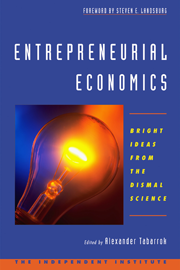Two children are squabbling over how to divide a pie. We need a method to divide the pie fairly. Parents will already know one answer—one child cuts and the second child chooses. The second child will choose the larger half which gives the first child the incentive to cut as evenly as possible. The first-cut, second-choose solution is a simple example of an incentive-compatible mechanism. Leonid Hurwicz, Eric Maskin, and Roger Myerson received the Nobel prize in economics for their study of incentive-compatible mechanisms or, more informally, “mechanism design.”
Mechanism design is a very general way of thinking about institutions. An institution or mechanism takes as input “messages” or “signals” from agents and it responds with an outcome. The idea of mechanism design is to create institutions that produce a desirable outcome while respecting the fact that agents have private information and are self-interested. It turns out that designing mechanisms that work well while respecting information and self-interest constraints is very difficult.
Ironically, the market, an undesigned mechanism, is the best example of a powerful incentive-compatible mechanism. Thus, in their explanation for the prize the Nobel committee wrote:
-
“These results support Friedrich Hayek’s (1945) argument that markets efficiently aggregate relevant private information.”
Mechanism design, however, is not simply a mathematical apparatus justifying the insights of Hayek. Leonid Hurwicz, the godfather of the field who is now in his nineties, was influenced by Hayek and by his opponent Oscar Lange. One can think of Hurwicz as trying to prove when the goals of Lange could work even taking into account the objections of Hayek.
It’s long been known that markets are challenged by externalities, public goods, asymmetric information and so forth. Standard public finance theory says “thus government”—a clear example of the nirvana fallacy.
Mechanism design theorists at least take their challenge seriously, and thus try to design institutions that work under the same constraints as the market—i.e. institutions that respect information and self-interest constraints. The results have been mixed. Typically the mechanisms that work in theory are very complicated—far more complicated than the market or other mechanisms that we see used in practice. I see little hope that mechanism design will rescue the dreams of Lange, et al.
More realistically, I see mechanism design as a tool to make markets more powerful. In some situations, for example, mechanism design shows that public goods can be voluntarily provided. In other situations, mechanism design can make government more effective, but it will do so by making government more “market-like.” Contracting-out of government services like garbage pickup, prisons, and roads, for example, can be carried out even farther if contracts are more carefully designed. The theory of mechanism design provides the template for thinking about the best possible types of contracts.
The most practical use of mechanism design to date illustrates my point. Mechanism design is the foundation for the sophisticated auctions that have been used to sell off broadcast spectrum. The moral here, however, is often misunderstood. The sophisticated auctions convinced governments that there was money in selling off spectrum, but the real gains came when spectrum, which was being wasted in government hands, was turned over to the private sector.
Overall, mechanism design increases our appreciation of markets, if only by showing how difficult it is to produce good outcomes while respecting the constraints that markets must satisfy. In a sense, mechanism design is to markets what genetic algorithms are to life. Theorists may one day design a better market mechanism or a better genetic code but for now the gains will come from using our deeper understanding to gently improve something that’s already pretty marvelous.












